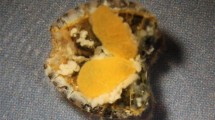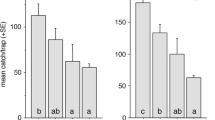Abstract
Fifty percent of anAmblyomma variegatum female population were able to find upwind-positioned targets containing the synthetic aggregation-attachment pheromone of this species or the pheromone componento-nitrophenol alone. The ticks were not attracted to the other components of the pheromone: methyl-salicylate and pelargonic acid. The mean time required for the ticks to reach a target at 1 m from the starting point was 3 min and 20 s.
Similar content being viewed by others
References
Baker, T.C., 1985. Chemical control of behaviour. In: G.A. Kerkut and L.I. Gilbert (Editors), Comprehensive Insect Physiology, Biochemistry and Pharmacology. Pergamon Press, Oxford, Vol. 9, pp. 621–672.
Gladney, W.J., Ernst, S.E. and Grabbe, R.R., 1974a. The aggregation response of the gulf coast tick on cattle. Ann. Entomol. Soc. Am., 67: 750–752.
Gladney, W.J., Grabbe, R.R., Ernst, S.E. and Oehler, D.D., 1974b. The gulf coast tick: evidence of a pheromone produced by males. J. Med. Entomol., 11: 303–306.
Gray, J.S., 1985. A carbon dioxide trap for prolonged sampling ofIxodes ricinus L. populations. Exp. Appl. Acarol., 1: 35–44.
Kennedy, J.S., 1977. Olfactory responses to distant plants and other odor sources. In: H.H. Shorey and J.J. McKelvey (Editors), Chemical Control of Insect Behavior: Theory and Application. Wiley, New York, pp. 67–91.
Norval, R.A.I. and Rechav, Y., 1979. An assembly pheromone and its perception in the tickAmblyomma variegatum (Acarina: Ixodidae). J. Med. Entomol., 6: 507–511.
Ostle, B., 1963. Statistics in Research. Iowa State University Press, Ames, IA, 2nd edn.
Rechav, Y. and Whitehead, G.B., 1978. Field trials with pheromone-acaricide mixtures or control ofAmblyomma hebraeum. J. Econ. Entomol., 71: 149–151.
Rechav, Y., Parolis, H., Whitehead, G.B. and Knight, M.M., 1977. Evidence for an assembly pheromone(s) produced by males of the bont tick,Amblyomma hebraeum (Acarina: Ixodidae). J. Med. Entomol., 14: 71–78.
Schöni, R., Hess, E., Blum, W. and Ramstein, K., 1984. The aggregation-attachment pheromone of the tropical bont tickAmblyomma variegatum Fabricius (Acari, Ixodidae): isolation, identification and action of its components. J. Insect Physiol., 30: 613–618.
Waladde, S.M. and Rice, M.J., 1982. The sensory basis of tick feeding behavior. In: F.D. Obenchain and R. Galun (Editors), Physiology of Ticks. Pergamon Press, Oxford, pp. 71–118.
Author information
Authors and Affiliations
Rights and permissions
About this article
Cite this article
Hess, E., De Castro, J.J. Field tests of the response of femaleAmblyomma variegatum (Acari:Ixodidae) to the synthetic aggregation-attachment pheromone and its components. Exp Appl Acarol 2, 249–255 (1986). https://doi.org/10.1007/BF01193957
Accepted:
Issue Date:
DOI: https://doi.org/10.1007/BF01193957




